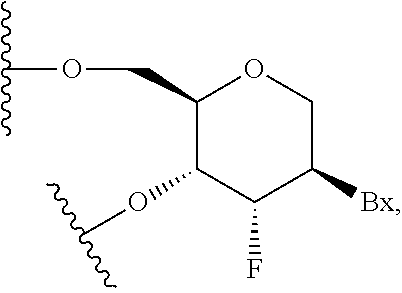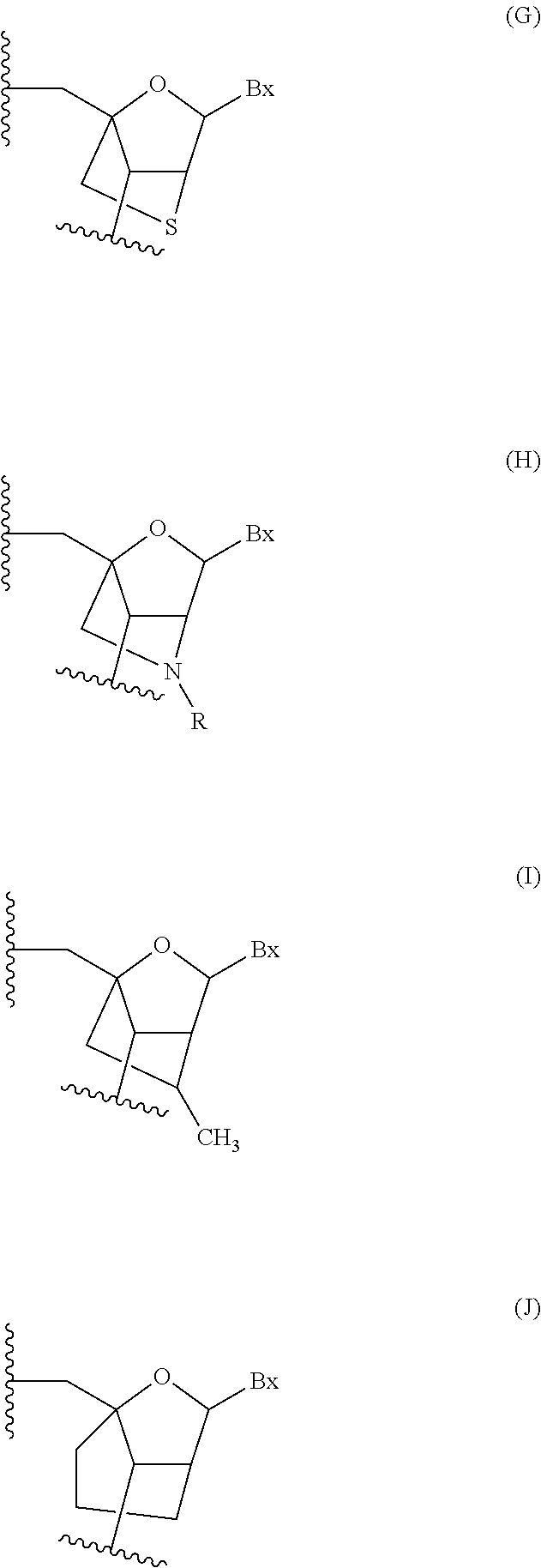Diagnosis and treatment of disease
a disease and diagnosis technology, applied in the field of diagnosis and treatment of disease, can solve problems such as ganglionic site neuronal loss, axonal degeneration, and drug composition, and achieve the effects of improving the quality of life and reducing the risk of side effects
- Summary
- Abstract
- Description
- Claims
- Application Information
AI Technical Summary
Benefits of technology
Problems solved by technology
Method used
Image
Examples
example 1
Antisense Inhibition of Human Transthyretin in HepG2 Cells
[0480]Antisense oligonucleotides were designed targeting a transthyretin nucleic acid and were tested for their effects on transthyretin mRNA in vitro. Cultured HepG2 cells at a density of 10,000 cells per well were transfected using lipofectin reagent with 50 nM antisense oligonucleotide. After a treatment period of approximately 24 hours, RNA was isolated from the cells and transthyretin mRNA levels were measured by quantitative real-time PCR. Human primer probe set RTS1396 (forward sequence CCCTGCTGAGCCCCTACTC, designated herein as SEQ ID NO: 5; reverse sequence TCCCTCATTCCTTGGGATTG, designated herein as SEQ ID NO: 6; probe sequence ATTCCACCACGGCTGTCGTCAX, designated herein as SEQ ID NO: 7). Transthyretin mRNA levels were adjusted according to total RNA content, as measured by RIBOGREEN®. Results are presented as percent inhibition of transthyretin, relative to untreated control cells.
[0481]The chimeric antisense oligonucl...
example 2
Antisense Inhibition of Human Transthyretin in HepG2 Cells by Oligonucleotides Designed by Microwalk
[0488]Additional gapmers were designed based on the gapmers presented in Table 3 that demonstrated an inhibition of at least 50%. These gapmers were designed by creating gapmers shifted slightly upstream and downstream (i.e. “microwalk”) of the original gapmers from Table 3. Gapmers were also created with various motifs, e.g. 5-10-5 MOE, 3-14-3 MOE, 2-13-5 MOE, and 4-11-5 MOE motifs. These gapmers were tested in vitro. Cultured HepG2 cells at a density of 10,000 cells per well were transfected using lipofectin reagent with 50 nM antisense oligonucleotide. After a treatment period of approximately 24 hours, RNA was isolated from the cells and transthyretin mRNA levels were measured by quantitative real-time PCR. The human primer probe set RTS3029 was used to measure transthyretin mRNA levels. Transthyretin mRNA levels were adjusted according to total RNA content, as measured by RIBOGRE...
example 3
Dose-Dependent Antisense Inhibition of Human Transthyretin in HepG2 Cells
[0497]Gapmers from Example 2 exhibiting significant in vitro inhibition of human transthyretin were tested at various doses in HepG2 cells. Cells were plated at a density of 20,000 cells per well and transfected using electroporation with 625 nM, 1250 nM, 2500 nM, 5000 nM and 10000 nM concentrations of antisense oligonucleotide, as specified in Table 5. After a treatment period of approximately 16 hours, RNA was isolated from the cells and transthyretin mRNA levels were measured by quantitative real-time PCR. Human transthyretin primer probe set RTS3029 was used to measure mRNA levels. Transthyretin mRNA levels were adjusted according to total RNA content, as measured by RIBOGREEN®. Results are presented as percent inhibition of transthyretin, relative to untreated control cells.
[0498]The half maximal inhibitory concentration (IC50) of each oligonucleotide is also presented in Table 5 and was calculated by plot...
PUM
| Property | Measurement | Unit |
|---|---|---|
| viscosity | aaaaa | aaaaa |
| temperature | aaaaa | aaaaa |
| viscosity | aaaaa | aaaaa |
Abstract
Description
Claims
Application Information
 Login to View More
Login to View More - R&D
- Intellectual Property
- Life Sciences
- Materials
- Tech Scout
- Unparalleled Data Quality
- Higher Quality Content
- 60% Fewer Hallucinations
Browse by: Latest US Patents, China's latest patents, Technical Efficacy Thesaurus, Application Domain, Technology Topic, Popular Technical Reports.
© 2025 PatSnap. All rights reserved.Legal|Privacy policy|Modern Slavery Act Transparency Statement|Sitemap|About US| Contact US: help@patsnap.com



